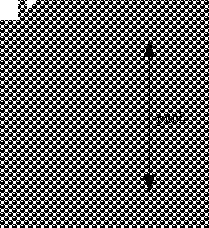What it shows:
The selective reflection of a specific wavelength of light through a chiral nematic liquid crystal is temperature dependent and forms the basis for LCD thermograms and thermometers.
How it works:
Liquid crystals are an intermediate state of matter or mesophase between (crystalline) solid and liquid. Substances that have a mesophase have a non-flexible rod-like molecular structure. Although in a liquid phase, the shape of the molecule and intermolecular forces means that the molecules retain a common preferred orientation. Two types of mesophase exist, the smectic phase where the substance retains a layered or stacking structure from the solid as well as a fixed orientation, and secondly the nematic phase, where only the molecular orientation is retained.
The molecular structure of certain liquid crystals (for example cholestryl myristate) gives them the property of chrality. Non-chiral molecules in the nematic phase will align to a specific direction (the director), whereas the molecules in chiral nematic liquid crystals favor a phase shift in director alignment between successive molecules. For a particular column of molecules, the phase shift will cause a 360° revolution of the director; one full turn being called the pitch of the liquid crystal figure 1). Light incident onto the surface of a chiral nematic liquid crystal will ordinarily be transmitted, but in the special case where the wavelength of the light equals the pitch of the molecules, the waves are reflected and interfere constructively. The reflection of this specific wavelength is hence very strong, and if it falls in the visible spectrum, the liquid crystal appears that color. This process is called selective reflection, and is very useful as a temperature indicator because the pitch length is temperature dependent.
figure 1. Stack of chiral nematic molecules.
The liquid crystal comes in the form of 15 × 30 cm sheets 1 where the internal composition determines the temperature-color relationship. Active temperature ranges are 20-25, 25-30, 35-36, 35-40, 40-45° Celsius.
Setting it up:
Depends on how you want to use them. The 25-30°C sheet can be activated by touch; a heat gun or IR lamp will activate the higher range sheets.
Comments:
The sheets can be used in their own right, as radiation detectors (as in the Infra-Red Radiation) or as part of a discussion on broader LCD properties.
References:
A. Guinier, The Structure of Matter from blue sky to liquid crystals (Edward Arnold 1984)
P. J. Collings, Liquid Crystals (Princeton University Press 1990)
1 A set of 10 × 15 cm sheets are available from CENCO (38293M)